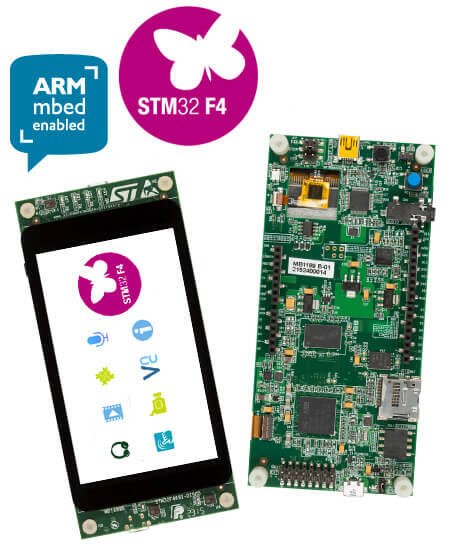ST STM32F469I Discovery
Overview
The STM32F469 Discovery kit features an ARM Cortex-M4 based STM32F469NI MCU with a wide range of connectivity support and configurations Here are some highlights of the STM32F469I-DISCO board:
STM32 microcontroller in BGA216 package
On-board ST-LINK/V2-1 debugger/programmer, supporting USB reenumeration capability
Flexible board power supply:
ST-LINK/V2-1 USB connector
User USB FS connector
VIN from Arduino* compatible connectors
Four user LEDs
Two push-buttons: USER and RESET
USB OTG FS with micro-AB connector
4-inch 800x480 pixel TFT color LCD with MIPI DSI interface and capacitive touch screen
SAI Audio DAC, with a stereo headphone output jack
Three MEMS microphones
MicroSD card connector
I2C extension connector
4Mx32bit SDRAM
128-Mbit Quad-SPI NOR Flash
Expansion connectors and Arduino UNO V3 connectors

More information about the board can be found at the 32F469IDISCOVERY website.
Hardware
STM32F469I-DISCO Discovery kit provides the following hardware components:
STM32F469NIH6 in BGA216 package
ARM® 32-bit Cortex® -M4 CPU with FPU
180 MHz max CPU frequency
VDD from 1.8 V to 3.6 V
2 MB Flash
384+4 KB SRAM including 64-Kbyte of core coupled memory
GPIO with external interrupt capability
LCD parallel interface, 8080/6800 modes
LCD TFT controller supporting up to XGA resolution
MIPI® DSI host controller supporting up to 720p 30Hz resolution
3x12-bit ADC with 24 channels
2x12-bit D/A converters
RTC
Advanced-control Timer
General Purpose Timers (17)
Watchdog Timers (2)
USART/UART (8)
I2C (3)
SPI (6)
1xSAI (serial audio interface)
SDIO
2xCAN
USB 2.0 OTG FS with on-chip PHY
USB 2.0 OTG HS/FS with dedicated DMA, on-chip full-speed PHY and ULPI
10/100 Ethernet MAC with dedicated DMA
8- to 14-bit parallel camera
CRC calculation unit
True random number generator
DMA Controller
- More information about STM32F469NI can be found here:
Supported Features
The Zephyr stm32f469i_disco board configuration supports the following hardware features:
Interface |
Controller |
Driver/Component |
|---|---|---|
NVIC |
on-chip |
nested vector interrupt controller |
UART |
on-chip |
serial port-polling; serial port-interrupt |
PINMUX |
on-chip |
pinmux |
GPIO |
on-chip |
gpio |
PWM |
on-chip |
pwm |
SPI |
on-chip |
spi |
SDIO |
on-chip |
SD-card controller |
Other hardware features are not yet supported on Zephyr porting.
The default configuration can be found in the defconfig file:
boards/arm/stm32f469i_disco/stm32f469i_disco_defconfig
Pin Mapping
STM32F469I-DISCO Discovery kit has 9 GPIO controllers. These controllers are responsible for pin muxing, input/output, pull-up, etc.
For mode details please refer to 32F469IDISCOVERY board User Manual.
Default Zephyr Peripheral Mapping:
UART_3 TX/RX : PB10/PB11 (ST-Link Virtual Port Com)
UART_6 TX/RX : PG14/PG9 (Arduino Serial)
I2C1 SCL/SDA : PB8/PB9 (Arduino I2C)
SPI2 NSS/SCK/MISO/MOSI : PH6/PD3/PB14/PB15 (Arduino SPI)
SDIO D0/D1/D2/D3/CLK/Detect : PC8/PC9/PC10/PC11/PC12/PG2
USB DM : PA11
USB DP : PA12
USER_PB : PA0
LD1 : PG6
LD2 : PD4
LD3 : PD5
LD4 : PK3
System Clock
STM32F469I-DISCO System Clock could be driven by internal or external oscillator, as well as main PLL clock. By default System clock is driven by PLL clock at 180MHz, driven by 8MHz high speed external clock.
Serial Port
The STM32F469 Discovery kit has up to 8 UARTs. The Zephyr console output is assigned to UART3. Default settings are 115200 8N1.
Programming and Debugging
Applications for the stm32f469i_disco board configuration can be built and
flashed in the usual way (see Building an Application and
Run an Application for more details).
Flashing
STM32F469I-DISCO Discovery kit includes an ST-LINK/V2 embedded debug tool interface. This interface is supported by the openocd version included in Zephyr SDK.
Flashing an application to STM32F469I-DISCO
First, connect the STM32F469I-DISCO Discovery kit to your host computer using the USB port to prepare it for flashing. Then build and flash your application.
Here is an example for the Hello World application.
# From the root of the zephyr repository
west build -b stm32f469i_disco samples/hello_world
west flash
Run a serial host program to connect with your board:
$ minicom -D /dev/ttyACM0
You should see the following message on the console:
Hello World! arm
Debugging
You can debug an application in the usual way. Here is an example for the Hello World application.
# From the root of the zephyr repository
west build -b stm32f469i_disco samples/hello_world
west debug
